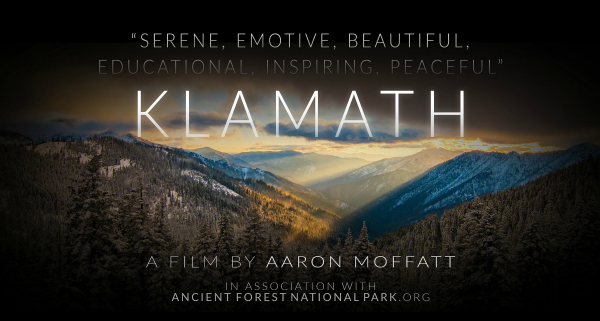Aaron Moffatt, a young Southern Oregonian film maker, has started his career with a visual triumph. Four years in the making, his film offers a stunning and gripping visual depiction of the amazing Kamath-Siskiyou forest. This feature length video will be the focus of the next Southern Oregon Climate Action Now General Meeting scheduled for 6:00 pm on Tuesday November 29th , 2016 at the Medford Public Library (205 S. Central Avenue, Medford). The program is free and open to the public.
The Klamath-Siskiyou (KS) area, dubbed the Red Rock Rainforest and the Galapagos of North America, includes the largest remaining and most biodiverse intact forest ecosystem in the United States outside of Alaska. The film depicts a year of natural beauty in the Klamath-Siskiyou region, an area which has been proposed as a UNESCO World Heritage Site. Klamath eloquently promotes an Ancient Forest National Park along the California-Oregon border.
The film’s message is urgent: this biodiversity hotspot must be protected. Film maker Aaron Moffatt says about the Klamath-Siskiyou, “Complex geology, climatic conditions, and impassibly rugged river canyons have inspired some of the greatest technological feats of history here.” “KS Film has spent the last four years filming in some very rugged forested land. It’s been, at times, a mighty fete lugging camera equipment into remote areas that are not readily accessible” says Alden Moffatt, who mapped the Ancient Forest National Park Proposal. “Aaron talked to many scientists before producing the film Klamath; “I didn’t want to get politics involved, just show what the Klamath-Siskiyou is. Repeatedly I heard that the area I was filming is one of the most biodiverse in the world due its proximity to the ocean, its diverse rock and soil types, and its jagged, multifaceted mountains.” This is among the most diverse coniferous forest in the world and served as a hideout for many plant species through the last Ice Age.
There are over a hundred roadless areas, wilderness areas, wild and scenic rivers, a national recreation area, and botanical areas that help protect the heart of this magnificent region. But many of those designations are administrative and could be reversed with the stroke of a pen. The threats to the area are mostly from fragmentation, isolating high elevation wilderness islands in a sea of low elevation clearcuts. But many factors threaten the biodiversity for which the region is famous: Mining, grazing, logging, air and water pollution, and weather and climate modification are pushing constantly to degrade this wonderland. Over the last 60 years, mighty fish runs have been reduced to a pittance, invasive species have taken over some ecosystems, clearcuts have denuded many epic lowland canyons, and water and air quality have been reduced.
“We would expect the Galapagos to have the greatest protection possible, and so should the Klamath-Siskiyou. The Ancient Forest National Park Proposal protect the heart of and the most intact portions of this extremely important region,” according to Alden Moffatt. “There are no national parks in the United States that protect a whole forest ecosystem, capturing the climatic spectrum from rainforest to desert.”
Although the film and Ancient Forest National Park Proposal may be controversial, there is a large economic upside to national parks. According to the LA Times: “National parks pumped $31 billion into local economies in 2010” The Ancient Forest National Park was one of National Parks Traveler Magazine’s top 5 picks for new national parks.
Join us on November 29th, 2016 for this rare treat – a stunning look at a local treasure.
